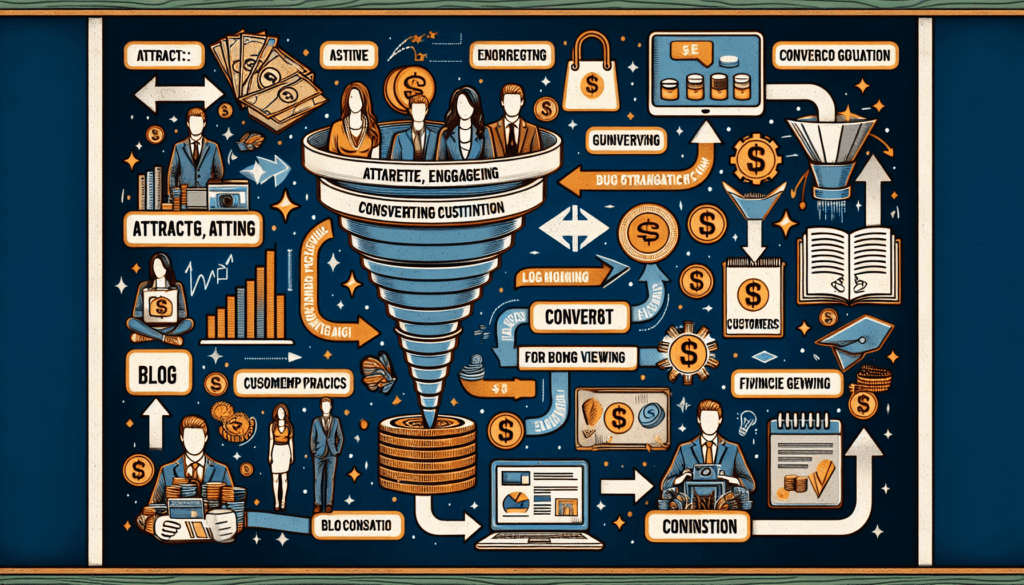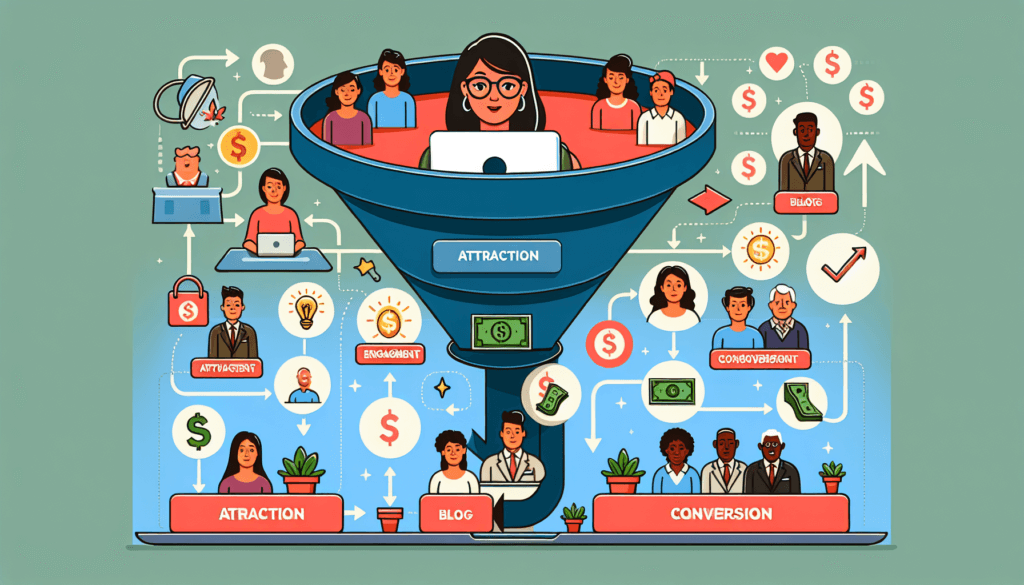In this article, you will discover the key steps to creating an effective sales funnel for blog monetization. Whether you’re a seasoned blogger or just starting out, understanding how to turn your blog into a profitable venture is crucial. By following these simple strategies, you will be able to attract and convert your audience into paying customers, maximizing your blog’s revenue potential. Get ready to unleash the power of a well-designed sales funnel and take your blog monetization to new heights.

Creating a Sales Funnel
Understand the Sales Funnel Concept
Before diving into the details of creating an effective sales funnel, it’s important to understand what a sales funnel is and how it works. A sales funnel is a visualization of the customer journey from when they first become aware of your brand or product to when they make a purchase.
The sales funnel is typically divided into several stages, each representing a different step in the customer’s decision-making process. These stages can include awareness, consideration, and decision. Understanding these stages and how they relate to your target audience is crucial in designing a successful sales funnel.
Identify Your Target Audience
Once you have a clear understanding of the sales funnel concept, the next step is to identify your target audience. Knowing your target audience is essential for effective marketing and sales strategies. Take the time to research and analyze your potential customers, their demographics, interests, and pain points. This information will help you tailor your messaging and ensure your sales funnel is targeted and effective.
Set Clear Goals and Objectives
Setting clear goals and objectives is vital for the success of your sales funnel. What do you want to achieve with your sales funnel? Are you aiming to increase sales, generate leads, or build brand awareness? By defining your goals, you can devise strategies and measure the success of your sales funnel accurately. Remember to set specific, measurable, achievable, relevant, and time-bound (SMART) goals to keep yourself focused and motivated.
Attracting Potential Customers
Produce High-Quality and Relevant Content
One of the most effective ways to attract potential customers to your sales funnel is by producing high-quality, relevant content. Create blog posts, videos, or podcasts that provide value and address your target audience’s pain points. By consistently delivering valuable content, you can position yourself as an authority in your niche and attract a steady stream of potential customers.
Optimize Your Blog for Search Engines
To maximize the visibility of your content and attract potential customers, it’s crucial to optimize your blog for search engines. Conduct keyword research to identify relevant keywords and incorporate them naturally into your content. Optimize your blog’s meta tags, headings, and URLs to improve your search engine rankings. Additionally, focus on creating informative and engaging content that encourages readers to share and link back to your blog.
Use Social Media Marketing
Social media platforms provide an excellent opportunity to attract potential customers to your sales funnel. Identify the social media channels where your target audience is most active and create a strong presence there. Share your content, engage with your audience, and participate in relevant conversations. Utilize social media advertising to reach a wider audience and drive traffic to your blog. By leveraging the power of social media, you can expand your reach and attract potential customers effectively.
Implement Email Marketing Strategies
Email marketing is a powerful tool for attracting potential customers and moving them through your sales funnel. Collect email addresses through lead magnets, such as free e-books or webinars, and build a subscriber list. Send out regular newsletters or automated email campaigns to nurture your leads and keep them engaged with your brand. Personalize your emails based on the recipient’s interests and previous interactions to increase their effectiveness. Email marketing allows you to build a relationship with potential customers and guide them towards making a purchase.
Generating Leads
Offer Valuable Lead Magnets
To entice potential customers into providing their contact information, offer valuable lead magnets. Lead magnets are free resources that provide immediate value to your target audience. They can be e-books, checklists, templates, or any other relevant content. Make sure your lead magnets address a specific pain point or problem your audience has. By offering something valuable in exchange for their email address, you can generate leads and start building a relationship with them.
Create Landing Pages
A landing page is a dedicated page on your website designed to convert visitors into leads. It typically contains a compelling headline, a clear call-to-action (CTA), and a lead capture form. Use landing pages to promote your lead magnets or offer free trials of your products or services. Make your landing pages visually appealing and easy to navigate. Test different designs and copy to optimize their conversion rates and maximize lead generation.
Utilize Call-to-Action (CTA) Buttons
A call-to-action (CTA) button is a powerful tool for generating leads. Place CTAs strategically throughout your website, blog posts, and emails to guide potential customers towards the next step in your sales funnel. Use clear, action-oriented language on your CTAs and make sure they stand out visually. Experiment with different CTA placements, colors, and copy to determine what works best for your audience.
Nurturing Leads
Use Email Marketing Automation
Email marketing automation allows you to nurture leads automatically and deliver personalized content at every stage of the customer journey. Set up automated email sequences based on your leads’ behavior and interests. Segment your email list to ensure that each lead receives relevant content. Use automation to send follow-up emails, recommend related products or services, and build trust and rapport with your leads.
Deliver Personalized and Targeted Content
Personalization is key to nurturing leads effectively. Tailor your content and messaging to match each lead’s interests and preferences. Use data you have collected, such as their browsing history or previous interactions, to deliver personalized recommendations and offers. Create dynamic content that adapts to each lead’s unique needs, ensuring they feel understood and valued.
Provide Value through Newsletters or Blog Subscriptions
Offering newsletters or blog subscriptions is an excellent way to nurture leads and provide ongoing value. Create a regular schedule for sending out newsletters or publishing new blog content. Make sure your content is informative, engaging, and relevant to your leads’ interests. By consistently delivering value, you can establish trust and credibility, keeping your leads engaged and moving them closer to becoming paying customers.

Converting Leads into Paying Customers
Build Trust and Credibility
Building trust and credibility is crucial in converting leads into paying customers. Offer high-quality products or services that deliver on their promises. Back up your claims with testimonials, case studies, or social proof. Provide transparent pricing and clear information about your company. Respond quickly and professionally to customer inquiries or concerns. By demonstrating trustworthiness, you can alleviate any concerns your leads may have and increase their likelihood of making a purchase.
Offer Irresistible Offers and Discounts
Creating irresistible offers and discounts can tip the scale in favor of converting leads into paying customers. Provide exclusive discounts or limited-time promotions to incentivize purchases. Offer bonuses or additional value for customers who make a purchase. Use scarcity and urgency techniques to create a sense of FOMO (fear of missing out) and encourage immediate action. By making your offers appealing and time-sensitive, you can boost conversions and increase sales.
Implement Upselling and Cross-selling Techniques
Once a lead has made a purchase, it’s an opportune time to implement upselling and cross-selling techniques. Upselling involves offering a higher-priced or upgraded version of the product or service the customer is interested in. Cross-selling involves suggesting related products or services that complement the customer’s purchase. Personalize your upselling and cross-selling efforts based on the customer’s preferences and previous buying behavior. By offering relevant and valuable additional options, you can increase the average order value and maximize your revenue.
Driving Sales
Create a Seamless Checkout Process
The checkout process plays a crucial role in driving sales. Make sure your checkout process is user-friendly and streamlined. Minimize the number of steps required to complete a purchase. Clearly display the total cost, shipping options, and any applicable taxes or fees. Offer multiple payment options to accommodate various preferences. Test your checkout process regularly to identify any bottlenecks or issues that may deter customers from completing their purchase.
Optimize Pricing Strategies
Pricing is a vital component of driving sales. Conduct market research to determine competitive pricing for your products or services. Consider offering different pricing tiers or packages to cater to different customer segments. Experiment with pricing strategies, such as offering limited-time discounts or free trials. Monitor the impact of your pricing changes on your sales and adjust accordingly to find the optimal pricing strategy for your target audience.
Provide Excellent Customer Support
Providing excellent customer support is crucial in driving sales and fostering customer loyalty. Make it easy for customers to contact you with inquiries or concerns. Offer multiple support channels, such as email, phone, or live chat. Respond promptly and professionally to customer inquiries. Train your support team to provide exceptional service and resolve issues efficiently. By going above and beyond to meet your customers’ needs, you can create a positive customer experience and encourage repeat sales.

Retaining Customers and Encouraging Repeat Sales
Implement Customer Retention Strategies
Retaining customers is just as important as acquiring new ones. Implement customer retention strategies to keep your existing customers engaged and encourage repeat sales. Offer personalized recommendations based on their purchase history. Provide exclusive offers, discounts, or rewards for loyal customers. Send out regular newsletters or emails to keep them informed about new products or updates. By investing in customer retention, you can build customer loyalty and turn your customers into brand advocates.
Offer Exclusive Membership or Loyalty Programs
Exclusive membership or loyalty programs are effective in retaining customers and encouraging repeat sales. Offer special perks or benefits to members, such as early access to new products, exclusive discounts, or free shipping. Encourage customers to join your program by highlighting the value they will receive. Use personalized communications to engage with your members and make them feel appreciated. By providing additional value to your loyal customers, you can strengthen their loyalty and encourage them to continue purchasing from you.
Provide Ongoing Value through Upskilling or Educational Content
Providing ongoing value to your existing customers is essential for fostering loyalty and encouraging repeat sales. Offer upskilling or educational content that helps your customers maximize the benefits of your products or services. Create guides, tutorials, or webinars that teach them new skills or provide industry insights. Regularly share informative blog posts or newsletters that address their pain points or challenges. By positioning yourself as a source of continuous learning and support, you can deepen your relationship with your customers and increase their loyalty.
Measuring and Analyzing Performance
Track Key Performance Indicators (KPIs)
Tracking key performance indicators (KPIs) is crucial for measuring the effectiveness of your sales funnel. Some essential KPIs to track include conversion rates, customer acquisition cost (CAC), customer lifetime value (CLV), and revenue generated. Set up analytics tools or software to capture relevant data and monitor your KPIs regularly. Use these insights to identify areas of improvement and optimize your sales funnel accordingly.
Monitor Conversion Rates
Conversion rates provide valuable insights into how effectively your sales funnel is converting leads into paying customers. Monitor conversion rates at each stage of the sales funnel to identify any bottlenecks or areas of improvement. If you notice a drop-off in conversions at a particular stage, investigate the potential causes and make the necessary adjustments to improve the conversion rate.
Utilize Google Analytics
Google Analytics is a powerful tool for analyzing the performance of your sales funnel. Set up Google Analytics on your website to track various metrics, such as website traffic, user behavior, and conversion rates. Use the data provided by Google Analytics to gain insights into your audience’s demographics, interests, and interactions with your website. Utilize these insights to refine your targeting, messaging, and overall sales funnel strategy.

Optimizing and Iterating the Sales Funnel
Perform A/B Testing
A/B testing is a valuable technique for optimizing your sales funnel. Test different variations of your landing pages, email subject lines, CTAs, or pricing strategies to determine what resonates best with your audience. Split your audience into different groups and randomly present different versions to them. Measure the performance of each variation and use the results to inform your future decisions. A/B testing allows you to continuously fine-tune your sales funnel for maximum effectiveness.
Analyze User Feedback
Listening to user feedback is an essential part of optimizing your sales funnel. Collect feedback from your customers through surveys, reviews, or social media interactions. Pay attention to both positive and negative feedback, as it can reveal areas of improvement or highlight what is working well. Use this feedback to address any pain points or concerns your customers may have and make necessary adjustments to your sales funnel.
Make Data-Driven Decisions
When optimizing your sales funnel, it’s crucial to base your decisions on data rather than assumptions. Use the insights gained from tracking KPIs, performing A/B testing, and analyzing user feedback to inform your decisions. Data-driven decision-making allows you to identify patterns, trends, and opportunities that may not be evident otherwise. Continuously analyze and iterate on your sales funnel based on the data and feedback you receive to maximize its effectiveness.
Building Relationships and Gaining Trust
Establish Yourself as an Authority
Building relationships and establishing trust with your audience is essential for the success of your sales funnel. Position yourself as an authority in your niche by consistently providing valuable and reliable information. Offer actionable advice, share industry insights, and showcase your expertise through blog posts, podcasts, or videos. Engage with your audience through comments, social media, or online communities to establish rapport and credibility. By establishing yourself as an authority, you can attract and retain a loyal audience.
Engage in Influencer Marketing
Influencer marketing is a powerful strategy for building relationships and gaining trust. Identify influencers or industry experts in your niche and collaborate with them to promote your brand or products. Leverage their credibility and reach to expose your brand to a wider audience. Engage with influencers by sharing their content, commenting on their posts, or collaborating on projects. By tapping into their existing relationships and credibility, you can quickly build trust with their audience.
Leverage Testimonials and Reviews
Testimonials and reviews are invaluable for building trust and credibility with potential customers. Collect testimonials from satisfied customers and display them prominently on your website or sales pages. Encourage customers to leave reviews on platforms like Google or Yelp. Respond to both positive and negative reviews to show that you value customer feedback. By showcasing positive experiences and addressing concerns, you can instill confidence in your potential customers and increase their trust in your brand.
In conclusion, creating an effective sales funnel is essential for blog monetization. By understanding the sales funnel concept, identifying your target audience, and setting clear goals and objectives, you can lay the foundation for a successful sales funnel. Attracting potential customers through high-quality content, social media marketing, and email marketing strategies is crucial in generating leads. Nurturing leads through email marketing automation, personalized content, and ongoing value is key to converting them into paying customers. Driving sales requires a seamless checkout process, optimized pricing strategies, and excellent customer support. Retaining customers and encouraging repeat sales is achieved through customer retention strategies, exclusive membership programs, and ongoing value provision. Measuring and analyzing performance, optimizing and iterating the sales funnel, and building relationships and gaining trust are vital components of a successful sales funnel. Implementing these strategies and continuously refining your sales funnel based on data and user feedback will ultimately lead to blog monetization success.



